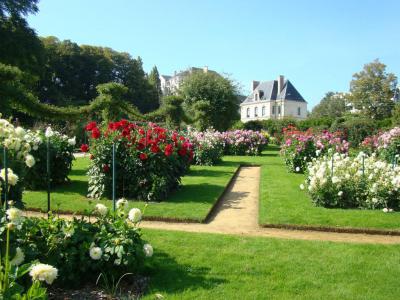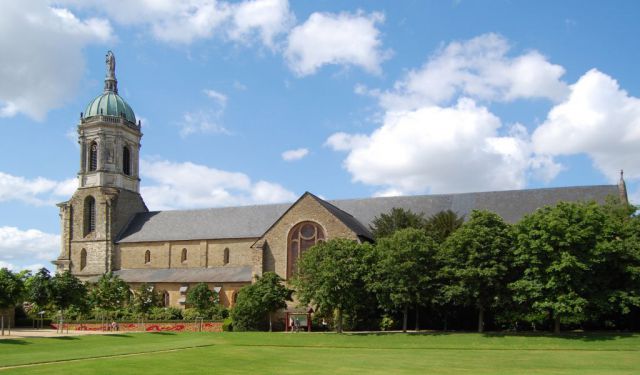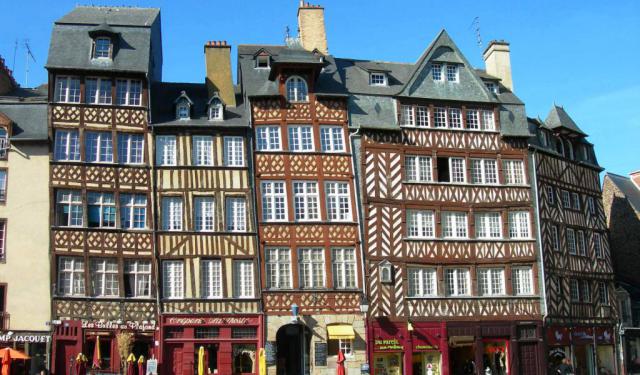
Parc du Thabor (Park of Thabor), Rennes (must see)
Formerly the Garden of a Monastery, Park of Thabor takes its name from Mount Tabor in Israel, where Jesus was transfigured. The Park was built on 25 acres on the highest hill in Rennes. It has rare trees, fountains, French, English, and botanical gardens, aviaries, orangeries, waterfalls, and sculptures.
The monks of Saint-Melaine Abbey started their vegetable gardens here in the 18th century, and that tradition of growing botanicals has persisted since then. The abbey was founded on the site of an ancient Roman necropolis by Saint Melaine, 6th century Bishop of Rennes. Gardens and orchards, tended by monks, surrounded the abbey. It was an attractive refuge for monks only. Unfortunately, it also occasionally was a holiday pillage spa for impulsive Vikings. The French Revolution opened things up.
In the early 19th century, the Park of Thabor was not yet publicly owned, but it was open to all. The planting of the Park and its gardens began in 1868. With the arrival of Napoleon III to the throne, the city built English, French, and botanical gardens on the site. These three important elements are combined in the Park.
The Carre Duguesclin is an English bowling green. Greenhouses and the French gardens face the vast central lawn. Beyond the English garden, at the far end, is a rose garden with over 2,000 varieties and a botanical garden holding 3,200 species from five continents. Classical sculptures by French artist Charles Lenoir liven things up.
Landscaping continued in the twentieth century. Fountain systems were refilled, waterfalls installed, and the Catherinettes garden was created. There were mills and caves, a music stand, and an aviary. There is a carousel, a restaurant, and a bar. Throughout the year there are concerts, festivals, and exhibitions. It is a "park for all seasons."
More than 1.5 million people visit the Park of Thabor each year. They stroll through the gates into one of the most beautiful gardens in France. The Park is open daily at 7:30 am.
The monks of Saint-Melaine Abbey started their vegetable gardens here in the 18th century, and that tradition of growing botanicals has persisted since then. The abbey was founded on the site of an ancient Roman necropolis by Saint Melaine, 6th century Bishop of Rennes. Gardens and orchards, tended by monks, surrounded the abbey. It was an attractive refuge for monks only. Unfortunately, it also occasionally was a holiday pillage spa for impulsive Vikings. The French Revolution opened things up.
In the early 19th century, the Park of Thabor was not yet publicly owned, but it was open to all. The planting of the Park and its gardens began in 1868. With the arrival of Napoleon III to the throne, the city built English, French, and botanical gardens on the site. These three important elements are combined in the Park.
The Carre Duguesclin is an English bowling green. Greenhouses and the French gardens face the vast central lawn. Beyond the English garden, at the far end, is a rose garden with over 2,000 varieties and a botanical garden holding 3,200 species from five continents. Classical sculptures by French artist Charles Lenoir liven things up.
Landscaping continued in the twentieth century. Fountain systems were refilled, waterfalls installed, and the Catherinettes garden was created. There were mills and caves, a music stand, and an aviary. There is a carousel, a restaurant, and a bar. Throughout the year there are concerts, festivals, and exhibitions. It is a "park for all seasons."
More than 1.5 million people visit the Park of Thabor each year. They stroll through the gates into one of the most beautiful gardens in France. The Park is open daily at 7:30 am.
Want to visit this sight? Check out these Self-Guided Walking Tours in Rennes. Alternatively, you can download the mobile app "GPSmyCity: Walks in 1K+ Cities" from Apple App Store or Google Play Store. The app turns your mobile device to a personal tour guide and it works offline, so no data plan is needed when traveling abroad.
Parc du Thabor (Park of Thabor) on Map
Sight Name: Parc du Thabor (Park of Thabor)
Sight Location: Rennes, France (See walking tours in Rennes)
Sight Type: Attraction/Landmark
Guide(s) Containing This Sight:
Sight Location: Rennes, France (See walking tours in Rennes)
Sight Type: Attraction/Landmark
Guide(s) Containing This Sight:
Walking Tours in Rennes, France
Create Your Own Walk in Rennes
Creating your own self-guided walk in Rennes is easy and fun. Choose the city attractions that you want to see and a walk route map will be created just for you. You can even set your hotel as the start point of the walk.
Rennes Historical Churches Walking Tour
Historical churches occupy a significant place in the cultural identity of Rennes, France. Travelers with a keen interest in religious history and architecture will find plenty to look at in this town.
Standing out majestically among the local ecclesiastical landmarks is Rennes Cathedral. Built in the 12th century, it underwent a centuries-long transformation from its Gothic origins to its... view more
Tour Duration: 1 Hour(s)
Travel Distance: 2.1 Km or 1.3 Miles
Standing out majestically among the local ecclesiastical landmarks is Rennes Cathedral. Built in the 12th century, it underwent a centuries-long transformation from its Gothic origins to its... view more
Tour Duration: 1 Hour(s)
Travel Distance: 2.1 Km or 1.3 Miles
Rennes Introduction Walking Tour
Rennes began its existence as Condate Redonum, a Gallic and Roman town at the confluence of the Ille and Vilaine rivers. During medieval times, it became one of the three major cities of Brittany, together with Vannes and Nantes. The city played an important role in the Stamped Paper Revolt in 1675. During the French Revolution, it became the headquarters of the republican army in the fighting... view more
Tour Duration: 2 Hour(s)
Travel Distance: 2.9 Km or 1.8 Miles
Tour Duration: 2 Hour(s)
Travel Distance: 2.9 Km or 1.8 Miles
Medieval Houses Walking Tour
From the late Middle Ages through to the end of the Ancien Régime (the period of Bourbon rule in France, from 1589 to 1789), a multitude of half-timbered houses were built in Brittany, and particularly in Rennes. Even today, the Breton capital is where half-timbered houses remain the most prevalent style of architecture, and a key element of the cultural heritage of the region reiterated in many... view more
Tour Duration: 1 Hour(s)
Travel Distance: 0.9 Km or 0.6 Miles
Tour Duration: 1 Hour(s)
Travel Distance: 0.9 Km or 0.6 Miles



